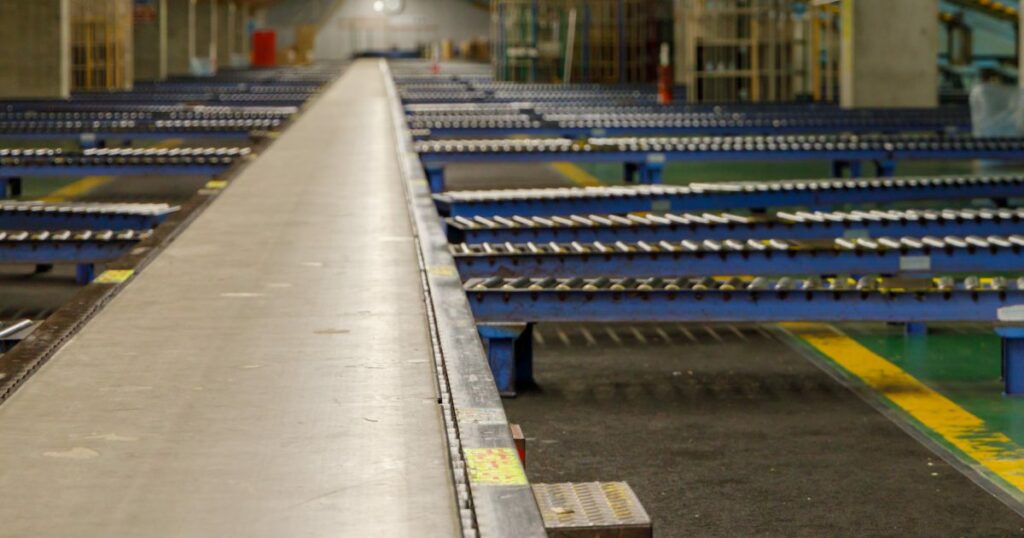Need Help?
We are here to help.
Our sales professionals can assist you in determining the type of components and solutions needed for your custom application.



Conveyors are one of the equipment (material handling) used to move goods within the premises of a distribution warehouse.
In this article, we will briefly explain what kind of conveyors are available and how to select the right one for your logistics warehouse.
A conveyor is defined in the Japanese Industrial Standards (JIS) as “a machine that continuously carries a load (material to be carried or transported).
A typical example is a belt conveyor. This may be easy for the general public to imagine, as they are also used at baggage claim areas at airports.
There are various types of conveyors other than belt conveyors.
Bulk conveyors and hazardous material conveyors
Conveyors can be broadly classified into two categories: bulk conveyors and bulk conveyors.
Conveyors that transport materials that are not grouped into a single unit, such as coal or earth and sand, are called “bulk conveyors.
Examples of bulk conveyors include screw conveyors with rotating spiral wings and trough belt conveyors with a belt cross section shaped like a U, V, or the bottom of a ship.
On the other hand, a conveyor that transports countable items such as cardboard boxes is called a “bulk conveyor” to distinguish it from other conveyors.
An example of a bulky item conveyor is a roller conveyor, which conveys the items on a series of rotating rollers.
The following sections will focus on the use of braided conveyor systems.
Purpose of Use of Conveyors in Logistics Warehouses
There are three main purposes for using conveyors in distribution warehouses: sorting, line work, and conveying to back-end processes.
Sorting
Sorting is used to sort multiple items by order or to sort packages by destination. The work can be fully automated in combination with automatic sorting machines or can be performed without moving people.
Line operations
Inspection and sealing are performed on the conveyor to the flowing packages. Productivity is improved by eliminating the need for workers to lift and move packages.
Conveying to subsequent processes
Finished products are placed on a conveyor and transferred to a subsequent process. Compared to conveying items individually using carts or pallets, this method saves labor and enables conveyance in small lots without reducing efficiency.
Driven roller conveyor
A driven roller conveyor is a conveyor that uses power to drive rollers to carry a load.
Some conveyors drive only a part of the rollers, while others drive all the rollers together.
The feature of this type is that it is relatively lightweight, making it easy to change the layout.
However, small or thin objects may fall through the gaps, and loads with a low coefficient of friction may not be conveyed well.
Compared to belt conveyors, it is not good at conveying loads up an incline because the frictional force applied to the load is smaller.
Free roller conveyor
This is a non-powered conveyor consisting of a series of rotating rollers.
It can convey by gravity using an incline, or by pushing by human power.
It is characterized by low installation cost, no wiring required due to the lack of power, and light weight, making it easy to change the layout.
However, because it is a gravity-based conveying method, it may only be able to convey automatically up to the distance that can be covered by the incline.
Sorting conveyor
Conveyors that can automatically sort conveyed materials are collectively referred to as sorting conveyors in particular.
A sorting conveyor is a machine designed for the purpose of sorting, so it may be more commonly called a “sorter.
There are various types of sorting conveyors, including those with branching devices such as rollers that pop up from underneath the conveyor surface to change direction, those that use pushers to push the load out from outside the conveyor, and those that slide the load down by tilting the running tray (tilt-type sorting conveyors).
Selection is based on the weight and size of the cargo and the required load handling.
This section has briefly explained the types and selection of conveyors, one of the materials handling systems indispensable for improving the efficiency of logistics warehouses.
What kind of conveyor should be introduced depends on the purpose of introduction and the type of cargo to be handled.
Free roller conveyors are inexpensive and versatile, but if sorting is the objective, a sorting conveyor will clearly have a greater impact on labor savings. The type of conveyor you choose will depend on the purpose of introduction, the cargo to be handled, and the investment cost, etc. We hope this information will be helpful to you when considering the best conveyor for your needs.
Our sales professionals can assist you in determining the type of components and solutions needed for your custom application.

Workshop 1,No.6,Liwei Industrial Zone, Shangbai Avenue,Luocun,Shishan Town,Nanhai,Foshan City,Guangdong,China
Mon — Sat: 8AM — 6PM